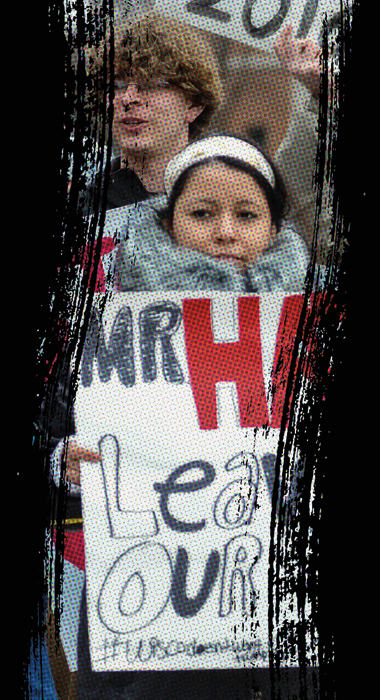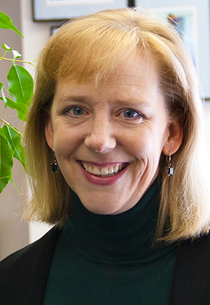The (Not So) Great Divide
 Wendy Scattergood (Political Science) frequently hears the comment, “it’s really bad out there” when people start discussing the 2016 election and the general polarization of the electorate. She challenges that assessment with a two-word response: civil war.
Wendy Scattergood (Political Science) frequently hears the comment, “it’s really bad out there” when people start discussing the 2016 election and the general polarization of the electorate. She challenges that assessment with a two-word response: civil war.
“A lot of people are freaked out by what’s going on right now in politics and how polarized both sides are, and that it’s never been this bad before,” she says. “But really what we are seeing is nothing that’s not too far out of the ordinary. The Civil War – now that was the height of political polarization.”
Scattergood, who is frequently tapped by Wisconsin news organizations looking for insights into poll numbers and the political landscape, says the current political landscape should not scare anyone.
“The extreme politics we have in the United States is nothing compared to what extreme politics look like in Western Europe,” she says. “Everything needs to be looked at in perspective and we need to get away from this hyperbole of people freaking out for no good reason.”
The fault lines now showing in the Republican Party are the crystallization of trends that have been going on for years, Scattergood says.
“The GOP has a lot of diverse political ideology in it – it’s similar to what the Democrats had in 1968 when you had hippies, civil rights supporters and George Wallace in the same party. When there is a lot of change, this is what historically happens. Politics become more polarized,” she said, speaking before the Nov. 8 polls in the U.S. “This has been coming for awhile. The question is – what happens next? Will the Democrats reach out to some of the Republicans who are saying they’ll vote for Hillary (Clinton) and look to bring them into the party?”
Scattergood says trying to get a handle on political polarization is challenging since a simple search on Amazon reveals 100 books on United States political polarization. There’s been little peer review done and some of the books are just “quackery,” she thinks.
“There are some books out there (on polarization) that get a lot of attention, but they offer no supporting research,” Scattergood says.
Most books are narrow-focused and don’t look at how gender and race, for example, play a role in polarization, she adds.
“Polarization pieces do not talk about gender while the gender politics pieces do not get in to polarization. I was looking for some book about polarization that included all the pieces of the pie, but could not find one,” says Scattergood, adding she is considering working on a project that addresses all aspects of polarization. “I really didn’t expect not to find that big-picture book out there.”
While some blame the media for the polarizing state of U.S. politics, Scattergood says it is not that easy.
“The media is a business and they won’t give us something we don’t want to read and watch,” she says. “The media may exasperate polarization, but they didn’t cause it.”
The popularity of 1980s talk radio is now visible in the multitude of ideological websites that cater to their loyal followers. But Scattergood says studies show that people are good at knowing when news media or websites have biases.
“These ideological sites are preaching to a choir that has already been converted,” she says. “A Clinton supporter won’t be swayed to change their vote after seeing something on Fox News.”
When it comes to U.S. history, it is normal for political parties and leaders to have vastly different views, Scattergood argues.
“Take a look at our Founding Fathers. They were divided on several issues. Then there’s slavery; that issue polarized the nation’s politics for nearly a century,” she says. “Really, what we have now is normal when it comes to politics.”
There’s no question Congress is now deeply polarized, with Republicans moving to the right and Democrats moving to the left, but Scattergood says that’s often the case.
“A lot of us just have this idea, based on how politics were after World War II and into the 1950s, that not being polarized was the norm,” she says. “But, in fact, being polarized is the norm for Congress.”
While pundits provide multiple reasons for polarization in Congress, such as campaign finance reform or gerrymandering, Scattergood isn’t easily swayed.
Regarding campaign finance, the 2010 Supreme Court decision that opened the door to so-called Super PACs only intensified the polarization among the parties – it did not cause it, she says. “It was already there,” Scattergood says.
As for gerrymandering – when legislatures create state or Congressional districts designed to ensure one party will keep the seat – Scattergood counters the argument that that is sparking more polarization by pointing to the Senate, which is elected by all voters within a state.
“The Senate and House are both equally polarized,” she says. “We see, as people grow in their party identification, they do begin to think more poorly of people in other parties, which can lead to polarization.”
But what about the American population as a whole? Scattergood believes when it comes to the average American, the differences are not as vast as those exhibited in Congress.
“Some scholars blame party activists for the polarization we see in our political system. Activists and party delegates tend to be more extreme on the issues than the average American,” she says. “Delegates (to party conventions) also tend to care about different issues than regular Americans.”
The same goes for the country’s political elite. “The elites on both side of the aisle are more polarized so that gives the impression that as a country we are more polarized,” Scattergood says. “But when you get down to it, most people are not that polarized in their beliefs.”
Scattergood likes to debunk the myth that “all government” is polarized. She says each level of government – federal, state and local – can have its own form of polarization or get along without the divisiveness. There are about 88,000 different government units in the country and while some are polarized, others are not, Scattergood says.
“Your local school district could be very polarized, but the one across the river isn’t,” she says. “That’s why, when people say government is all polarized, I have to disagree – not every unit of government across the country is polarized. We need to take a broader view.”
 About Wendy Scattergood
About Wendy ScattergoodWendy Scattergood (Political Science) is a regular guest on Wisconsin Public Radio, serving as the analyst twice a year to answer questions regarding the Wisconsin Public Radio/St. Norbert College Survey Center Wisconsin Survey, in addition to serving as a guest expert on other state and political issues as they arise. She also coordinates the Brown County Quality of Life Survey.
Before joining the St. Norbert College political science faculty in 2000, Scattergood taught political science at the University of Wisconsin-Green Bay. She also worked as an economic and research analyst for Washington State government for several years prior to graduate school.
Nov. 14, 2016











